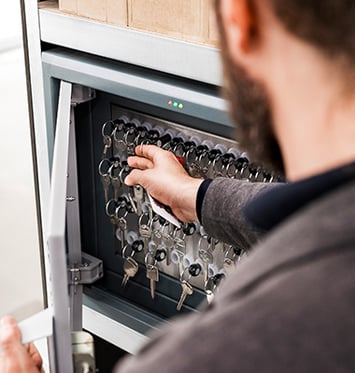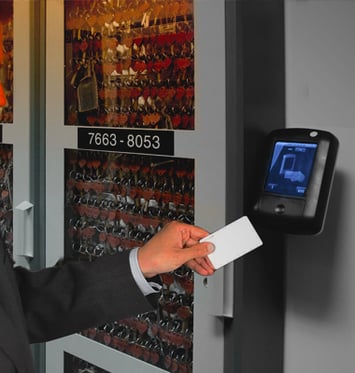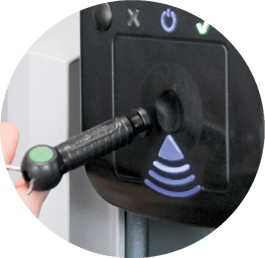By Jay Palter | June 29, 2022
Table of Contents
Secure key management systems have been a common business tool for decades because they serve a vital function. Users authenticate themselves, sign a key out, and return it later. It isn’t the smartest technology and has shortcomings, but it is what it is, right?
Not necessarily.
What if there were one addition you could make to a secure key management system that transformed it into a smart business management tool? What if one feature was the most important one you needed to consider when comparing different key systems? Well, there is, and it is radio frequency identification (RFID) key tags.
Are key tags the most important feature you need to consider? We believe so. This article unpacks the difference wireless RFID tracking makes in how you use a key system. If you’re considering the purchase of a new key system, read on so you can make an informed choice.
Why Use a Secure Key Management System?
If your business has physical keys or RFID key fobs, you need some type of key control process. A secure key management system is often the cornerstone of that process. They store idle keys just like any locker or cabinet could, but they also automate the distribution of keys.
Using a key management system provides several specific benefits over a manual key distribution process. It doesn’t matter whether it is an RFID system or a traditional metal-on-metal contact system. They all help with these things.
Security
Electronic access control ensures that only authorized users are allowed in the key cabinet. In addition, you can restrict who has access to which keys based on individual role, job type, or department.
Risk management
Eliminating the possibility of human error leading to lost or stolen keys helps your organization better manage risk. For example, you’ll reduce the chance of costly rekeyings eating up your budget. And if you’re in a regulated industry, mitigating the risk of getting hit with costly fines that come with security breaches.
Reduced costs
Automating key management allows you to redirect human staff from time-consuming and tedious overhead administration to more revenue-generating activities. Most of the time spent on key management is routine, perfect for automation. And the remaining percentage that needs human intervention becomes much easier with the software tools you get in an electronic system.
What You’ll Find in Any Secure Key Management System
RFID-enabled or otherwise, you’ll find a few core components in any secure key management system.
Key Cabinets
standards help you efficiently and consistently deliver high-quality products or services. Typically referred to as ISO 9001, this is by far the most popular of the ISO 9000 family of standards. The ISO 9000 family contains 14 standards in total, but you can only certify to ISO 9001:2015.

Access Terminals
The system controls access to the key cabinet from an access terminal. These terminals can support a range of different authentication options depending on the sophistication of the key system. At the low-cost, low-security end, you can use PIN codes and swipes. Moving up the scale, you could use RFID access fobs or smartphone authentication. And at the top end of the cost/security spectrum are biometrics, like facial recognition, iris eye scans, and thumbprints.

Reporting
No matter which key management system you buy, they all offer some level of reporting through key management software. You can have the software send you reports on transactions, late returns, missing keys, and many other basic operational details you need to know about key usage.

But What is the Most Important Feature?
We’ve already tipped our hand on this. Despite the importance of all of those other technical features, the single most important features of a key management system are the key tags. Those little bits of plastic and metal used to identify and lock key rings are the focal point of a key system’s operations.
Traditional key tags rely on metal-on-metal contacts to operate. Newer, smarter, more advanced systems used radio frequency identification tags, for example, Real Time Networks’ KeyTracer line of smart key lockers.
What is RFID
Radiofrequency identification is a short-range wireless communication standard used in various products.
How traditional metal contact key systems work
RFID and metal key tags are very different to use and maintain. Metal-on-metal key tags require physical contact between a fingernail-sized metal plate on the key tag and a matching plate inside the lock slot. Those metal contacts get oily and dirty over time. After enough buildup, the contact stops working, and a technician must meticulously clean each contact with rubbing alcohol and a cotton swab. In addition, metal contact tags can only lock in a lock slot when inserted in one direction. Inserted upside down, the key tag or the lock slot might break.
Management software
Traditional metal-on-metal key systems are 20th-century technology running on 20th-century software. Modern RFID systems use secure web-based software, making them much easier to use. You can access the key system dashboard from any authorized PC, phone, or tablet.
The Benefits of an RFID Key System
So those are the functional differences between a traditional metal contact key locker and an RFID key locker. But what advantages does RFID key security actually hold?
Complete key accountability
 Metal contact lock slots only confirm that a keyring is in place. They can’t verify the identity of individual key rings. That leads to situations where employees will hide keys they want to keep to themselves in out-of-the-way lock slots.
Metal contact lock slots only confirm that a keyring is in place. They can’t verify the identity of individual key rings. That leads to situations where employees will hide keys they want to keep to themselves in out-of-the-way lock slots.
RFID tags verify the identity of each key ring deposited. There is no default or “home” lock slot for each key ring, users can return them wherever they want, and when the next person signs out those keys, the slot lights up, showing the next user which ring to take. This key identification can eliminate hours upon hours of searching for keys someone is trying to keep for themselves or just returned to an unexpected location.
Cabinet upkeep is close to zero
 On the other hand, RFID tags don’t require physical contact to verify their identity to key locker sensors. So no matter how dirty they get, they still scan fine at a key locker.
On the other hand, RFID tags don’t require physical contact to verify their identity to key locker sensors. So no matter how dirty they get, they still scan fine at a key locker.
RFID tags don’t need a flat surface to facilitate metal-on-metal contact, so they can be any shape you want. However, in a KeyTracer system, they’re round, which means there’s no wrong way to insert them. As a result, it is impossible for an inattentive employee to accidentally return a key tag upside down and break a lock slot.
RTN key tags are hardened plastic and almost impossible to break, which is why RTN offers a lifetime warranty. Watch them survive a series of torture tests.
Customizable workflow support
Some interesting workflow support opportunities open up once you can identify individual key rings during transactions. For example, you can create customizable checklists that employees must complete at signout or return. If a worker signs a fleet vehicle key back in, you can prompt them to log mileage, gas level, and any new damage to the vehicle. The system becomes a complete fleet management solution.
Or, if you have keys to access restricted spaces, you can set curfews on key sign-outs and receive instant alerts when they’re returned, so you know they’re safe. Or if they’re not returned within a specified timeframe.
Eliminate human error
 Metal contact key systems and straight-up pen and paper systems require much manual control and oversight. Unfortunately, that leaves many opportunities for human error to creep into different processes. Such as lost keys, misplaced keys, and incorrectly recorded transactions.
Metal contact key systems and straight-up pen and paper systems require much manual control and oversight. Unfortunately, that leaves many opportunities for human error to creep into different processes. Such as lost keys, misplaced keys, and incorrectly recorded transactions.
RFID key systems don't allow those mistakes. Since the key system automatically monitors every transaction, human error isn’t possible for any transactions within the system's control. And when someone forgets to return keys on time, outside of the system’s control, it can issue an alert for a supervisor to investigate.
New insights
Automated RFID key tracking systems provide detailed insights on when, where, and how keys are being used. In addition, the modern software in these systems gives you fine grain control and can analyze performance trends as data accumulates over time, revealing trends you might not see otherwise.
RFID Key Control Streamlines Important Operations
Upgrading your key control with RFID key management simplifies a complex work process and will generate valuable business intelligence about how your personnel use keys. If your business is looking to be a leader in the 21st century, you need to upgrade to 21st-century technology for some of your most important management and security tasks.
Want to learn more?
Check out our Guide Best Practices for Physical Key Management.Subscribe to our blog

Jay Palter
Vice President of Marketing & Partnerships





